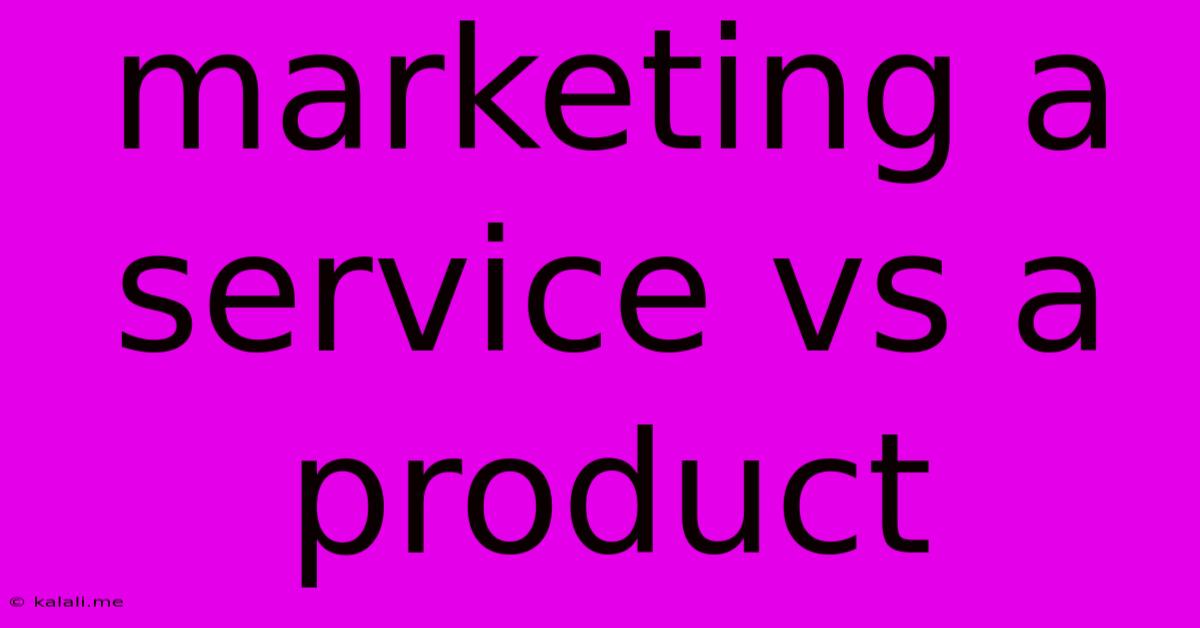Marketing A Service Vs A Product
Kalali
Jun 15, 2025 · 3 min read

Table of Contents
Marketing a Service vs. a Product: Key Differences and Strategies
Marketing a service is fundamentally different from marketing a product. While both aim to attract customers and drive sales, the strategies, challenges, and approaches vary significantly. This article delves into the key distinctions between marketing a service and a product, outlining effective strategies for each. Understanding these differences is crucial for achieving success in your chosen market.
What's the core difference? Intangibility. Products are tangible; you can see, touch, and feel them. Services, on the other hand, are intangible experiences. This core difference impacts every aspect of your marketing strategy.
Marketing a Product: Tangible Advantages & Challenges
Advantages:
- Easy to demonstrate: Products can be displayed, showcased, and even sampled, making it simpler to communicate their value proposition.
- Consistent quality: Manufacturing processes often ensure a degree of consistency in product quality, simplifying quality control and customer expectations.
- Inventory management: Products can be stored and managed, allowing for forecasting and strategic stock control.
- Branding is easier: A strong visual brand identity can be easily associated with a tangible product. Think of iconic product packaging!
Challenges:
- Competition is fierce: Product markets are often saturated, requiring strong differentiation and competitive pricing strategies.
- Managing inventory: Storing and managing inventory can be costly and complex, especially with perishable goods.
- Product lifecycle: Products have a limited lifespan, requiring continuous innovation and new product development.
Effective Product Marketing Strategies:
- Focus on features and benefits: Highlight what makes your product unique and how it solves customer problems.
- High-quality product photography and videography: Showcase your product's appearance and functionality.
- Leverage online marketplaces: Utilize platforms like Amazon or Etsy to reach a wider audience.
- Targeted advertising: Use platforms like Google Ads or social media advertising to reach specific demographics.
- Build a strong brand identity: Create a memorable brand that resonates with your target audience.
Marketing a Service: Intangibility and its Implications
Challenges:
- Intangibility: Services cannot be physically touched or seen, making it harder to communicate value.
- Perishability: Unsold service capacity is lost forever. A missed appointment is revenue lost.
- Variability: Service quality can vary depending on the service provider and the customer's experience.
- Inseparability: The service provider is often directly involved in the service delivery, impacting the customer experience.
Advantages:
- Customization: Services can be tailored to individual customer needs, offering a personalized experience.
- Relationship building: Strong customer relationships can lead to repeat business and referrals.
- Scalability: Depending on the service, scaling can be relatively easier compared to manufacturing a physical product.
Effective Service Marketing Strategies:
- Focus on building trust and credibility: Testimonials, case studies, and client reviews are essential.
- Highlight the experience: Emphasize the benefits and positive feelings associated with your service.
- Build a strong personal brand: Your reputation as a service provider is crucial for success.
- Content marketing is key: Blogs, articles, and videos can establish you as an expert and build trust.
- Excellent customer service: Exceptional service delivery directly impacts customer loyalty and referrals.
Conclusion: Finding the Right Approach
Ultimately, both product and service marketing require a deep understanding of your target audience and a well-defined value proposition. However, the strategies employed must account for the tangible nature of a product versus the intangible aspects of a service. By focusing on the unique characteristics of each, you can develop a tailored marketing plan that drives growth and achieves your business objectives. Remember that consistent monitoring, analysis, and adaptation are key to long-term success in any marketing endeavor.
Latest Posts
Latest Posts
-
What Mountain Range Divides Europe And Asia
Jun 15, 2025
-
Behaviorism Focuses On Which Of The Following
Jun 15, 2025
-
Which Is The Largest Satellite In The Solar System
Jun 15, 2025
-
What Sea Separates Europe And Africa
Jun 15, 2025
-
Fort Valley State University Gpa Requirements
Jun 15, 2025
Related Post
Thank you for visiting our website which covers about Marketing A Service Vs A Product . We hope the information provided has been useful to you. Feel free to contact us if you have any questions or need further assistance. See you next time and don't miss to bookmark.